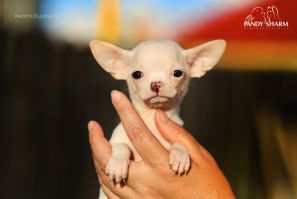
So, you’ve gone through all the fun of choosing the right puppy and you are now the happy owner of a Pomeranian, Beaver Yorkie or a Yorkshire terrier puppy with a perfect bite. Keep reading this article to learn what this actually means, who and what determines that the bite is perfect and how to make sure that the perfect bite does not get lost as your puppy’s teeth change.
What is the right bite?
Each pure bred puppy must pass a standardized check at a club or kennel at the age of 45-60 days. An expert cynologist from the RKF (Russian Cynological Federation) examines the puppy and gives him an assessment; teeth are one of the most important parts of this evaluation.
The term “correct bite” refers to the way the upper and lower jaws of a dog fit together and to the state of their individual teeth. The so-called scissor bite is ideal for Pomeranians and Yorks. It must match the following description: the upper teeth (6 incisors and two canines) must duplicate the lower teeth (6 incisors and two canines), with the upper jaw closing over the lower one. Incisors should be in the correct place and have the right degree of slope.
Change of teeth in puppies of small breeds
 |
 |
| начало смены зубов | верхние резцы уже сменились |
However, it is not enough just to get a puppy with the right bite; you also need to check how the teeth move as they develop, in order to make sure that this perfect bite is maintained as they grow, this is particularly true if you plan to continue to participate in shows and breeding. In puppies of small breeds such as Pomeranians or Yorkshire terriers, the change of teeth occurs approximately at the age of four months and three weeks. At this age, it is best to contact a competent veterinarian or experienced and expert breeder with a good reputation for being able to manage the process of changing teeth.
I strongly recommend that you take this opportunity to have a veterinarian remove the four central upper teeth along with the upper incisors even if they have not yet begun to show signs of being loose. Very often, the upper molars begin to grow without "waiting" for the milk teeth to fall out. This means that there needs to be room in the mouth for a new row of molars to grow evenly and in the right place, without catching or snagging. Strongly seated upper milk teeth have large roots, which can interfere with this.
But I categorically do not recommend the simultaneous removal of the lower incisors (you sometimes hear such advice)
First, they usually change without problems themselves,
Secondly, too much "freedom" in the teeth can lead to them growing unevenly and with the wrong degree of slope, which again brings the risk of the puppy developing an incorrect bite.
At what point should I remove the incisors?
 |
| на картинке ситуация, требующая экстренного вмешательства |
If the canine teeth are removed early, there is the risk of leaving a fragment of the root in the jaw, this happens if the tooth is still "not ready" for removal. For this reason, I recommend removing the milk canines only when the root is the same size as the dairy canines, i.e. when the line of the top of the incisors is 0.3-0.4 mm below the top of the new canine.
Lower dairy canines must be removed when the roots grow about their half length. If this is not done, there is a risk that the root canine can hit against the palate and not take its place in the roof of the mouth.
It is very important to find a skilled veterinarian who can remove teeth without leaving a piece of root in the jaw.
It may be that the teeth will change correctly and without the intervention of a veterinarian, but it is very important that you undertake constant timely monitoring during this period.
If you bought the puppy from our kennel and you have the opportunity to visit us during the change of teeth – 
I'll be glad to help you. If you live far away and do not have the chance to come and visit us, send me close-up photos of your kid's "smile" by e-mail, Viber or WhatsApp during this time will help me to help you to notice any problem in good time and promptly recommend that you have the tooth extracted or try another solution.
We wish good health to all pets and their owners.
In the next article, I will talk about the care of teeth in dogs and the proper cleaning of teeth.
Elena Gainulina,
veterinarian, RKF cynologist,
owner/breeder of the kennel "ot Pandy Sharm".

